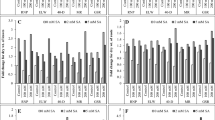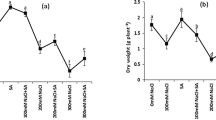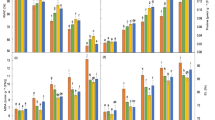Abstract
Salinity, as a serious and prevalent abiotic stress, causes widespread crop losses by restricting plant growth and production throughout the world. In this study, the biochemical and molecular responses of the pistachio (Pistacia vera L.) plant were studied under NaCl and salicylic acid (SA) treatments using hydroponically grown salt tolerant (Ghazvini) and salt sensitive (Sarakhs) pistachio cultivars. NaCl treatment (250 mM) increased the production of hydrogen peroxide (H2O2) and malondialdehyde (MDA) and the activity of antioxidant enzymes in both cultivars. In the sensitive cultivar, the H2O2 content was higher than the tolerant cultivar, especially in the roots. SA application to both salt-stress-treated cultivars resulted in an increase in photosynthetic pigment contents and antioxidant enzyme activity and a decrease in the H2O2 and MDA contents. After NaCl treatment, the isochorismate synthase (ICS) gene was upregulated in Ghazvini which leads to an increase in the SA content of the salt tolerant pistachio cultivar. In contrast, the salt treatment downregulated the expression of the ICS gene in Sarakhs. The ICS gene expression was positively regulated by SA treatment under the salt stress condition. Our results suggest that Ghazvini has higher salinity tolerance than Sarakhs due to its higher antioxidant capacity, photosynthetic pigment content, and the cultivar-specific expression pattern of the ICS gene. In this study, the potential alleviative effects of SA on the adverse effect of salt stress in P. vera (Pistacia vera) were also identified and highlighted.







Similar content being viewed by others
References
Abeles FB, Biles CL (1991) Characterization of peroxidases in lignifying peach fruit endocarp. Plant Physiol 95:269–273. https://doi.org/10.1104/pp.95.1.269
Acosta-Motos JR, Hernandez JA, Alvarez S, Barba-Espin G, Sanchez-Blanco MJ (2017) The long-term resistance mechanisms, critical irrigation threshold and relief capacity shown by Eugenia myrtifolia plants in response to saline reclaimed water. Plant Physiol Biochem 111:244–256. https://doi.org/10.1016/j.plaphy.2016.12.003
Aebi H (1974) Catalase. In: Bergmeyer HV (ed) Methods in enzymatic analysis. Academic Press Inc, New York, pp 673–686. https://doi.org/10.1016/B978-0-12-091302-2.50032-3
Asada K (2006) Production and scavenging of reactive oxygen species in chloroplasts and their functions. Plant Physiol 141:391–396. https://doi.org/10.1104/pp.106.082040
Ashraf M (2003) Relationships between leaf gas exchange characteristics and growth of differently adapted populations of Blue panicgrass (Panicum antidotale Retz.) under salinity or waterlogging. Plant Sci 165:69–75. https://doi.org/10.1016/S0168-9452(03)00128-6
Ashraf M (2004) Some important physiological selection criteria for salt tolerance in plants. Flora 199:361–376. https://doi.org/10.1078/0367-2530-00165
Ashraf M, Harris PJ (2013) Photosynthesis under stressful environments: an overview. Photosynthetica 51:163–190. https://doi.org/10.1007/s11099-013-0021-6
Bastam N, Baninasab B, Ghobadi C (2013) Improving salt tolerance by exogenous application of salicylic acid in seedlings of pistachio. Plant Growth Regul 69:275–284. https://doi.org/10.1007/s10725-012-9770-7
Boatwright JL, Pajerowska-Mukhtar K (2013) Salicylic acid: an old hormone up to new tricks. Mol Plant Pathol 14:623–634. https://doi.org/10.1111/mpp.12035
Catinot J, Buchala A, Abou-Mansour E, Metraux JP (2008) Salicylic acid production in response to biotic and abiotic stress depends on isochorismate in Nicotiana benthamiana. FEBS Lett 582:473–478. https://doi.org/10.1016/j.febslet.2007.12.039
Chen Z, Zheng Z, Huang J, Lai Z, Fan B (2009) Biosynthesis of salicylic acid in plants. Plant Signal Behav 4:493–496. https://doi.org/10.4161/psb.4.6.8392
Crane JC (1978) Pistachio tree nuts. Avipublishing Company, Westport
Demmig-Adams B, Adams WW III (1996) The role of xanthophyll cycle carotenoids in the protection of photosynthesis. Trends Plant Sci 1:21–26. https://doi.org/10.1016/S1360-1385(96)80019-7
Durner J, Klessig DF (1996) Salicylic acid is a modulator of tobacco and mammalian catalases. J Biol Chem 271:28492–28501. https://doi.org/10.1074/jbc.271.45.28492
Faostat F (2018). Food and agriculture organization of the United Nations (FAO). http://www.fao.org/faostat/en/-data/QC
Ferguson L, Poss J, Grattan S, Grieve C, Wang D, Wilson C, Donovan T, Chao CT (2002) Pistachio rootstocks influence scion growth and ion relations under salinity and boron stress. J Am Soc Hortic Sci 127:194–199. https://doi.org/10.21273/JASHS.127.2.194
Ghamari M, Hosseininaveh V, Talebi K, Nozari J, Allahyari H (2019) Biochemical characterization of the induced immune system of pistachio (Pistacia vera) by Salicylic Acid. Int J Fruit Sci 20:117–132. https://doi.org/10.1080/15538362.2019.1586025
Giannopolitis CN, Ries SK (1977) Superoxide dismutases: I. Occurrence in higher plants. Plant Physiol 59:309–314. https://doi.org/10.1104/pp.59.2.309
Gomathi R, Rakkiyapan P (2011) Comparative lipid peroxidation, leaf membrane thermostability, and antioxidant system in four sugarcane cultivars differing in salt tolerance. Int J Plant Physiol Biochem 3:67–74. https://doi.org/10.5897/IJPPB.9000009
Gossett DR, Millhollon EP, Lucas M (1994) Antioxidant response to NaCl stress in salt-tolerant and salt sensitive cultivars of cotton. Crop Sci 34:706–714. https://doi.org/10.2135/cropsci1994.0011183X003400030020x
Gunes A, Inal A, Alpaslan M, Cicek N, Guneri E, Eraslan F, Guzelordu T (2005) Effects of exogenously applied salicylic acid on the induction of multiple stress tolerance and mineral nutrition in maize (Zea mays L.). Arch Agron Soil Sci 51:687–695. https://doi.org/10.1080/03650340500336075
Hajiboland R, Norouzi F, Poschenrieder C (2014) Growth, physiological, biochemical and ionic responses of pistachio seedlings to mild and high salinity. Trees 28:1065–1078. https://doi.org/10.1007/s00468-014-1018-x
Hamayun M, Khan SA, Khan AL, Shin JH, Ahmad B, Shin DH, Lee IJ (2010) Exogenous gibberellic acid reprograms soybean to higher growth and salt stress tolerance. J Agric Food Chem 58:7226–7232. https://doi.org/10.1021/jf101221t
Hayat Q, Hayat S, Irfan M, Ahmad A (2010) Effect of exogenous salicylic acid under changing environment: a review. Environ Exp Bot 68:14–25. https://doi.org/10.1016/j.envexpbot.2009.08.005
Heath RL, Packer L (1968) Photoperoxidation in isolated chloroplasts. I. Kinetics and stoichiometry of fatty acid peroxidation. Arch Biochem Biophys 125:189–198. https://doi.org/10.1016/0003-9861(68)90654-1
Hernandez JA, Ferrer MA, Jimenez A, Barcelo AR, Sevilla F (2001) Antioxidant systems and O2−/H2O2 production in the apoplast of pea leaves. Its relation with salt-induced necrotic lesions in minor veins. Plant Physiol 127:817–831. https://doi.org/10.1104/pp.010188
Hunter LJ, Westwood JH, Heath G, Macaulay K, Smith AG, Macfarlane SA, Palukaitis P, Carr JP (2013) Regulation of RNA-dependent RNA polymerase 1 and isochorismate synthase gene expression in Arabidopsis. PLoS ONE 8(6):e66530. https://doi.org/10.1371/journal.pone.0066530
Isayenkov SV, Maathuis FJM (2019) Plant salinity stress: many unanswered questions remain. Front Plant Sci 10:80. https://doi.org/10.3389/fpls.2019.00080
Jannesar M, Seyedi SM, Moazzzam Jazi MM, Niknam V, Ebrahimzadeh H, Botanga C (2020) A genome-wide identification, characterization and functional analysis of salt-related long non-coding RNAs in non-model plant Pistacia vera L. using transcriptome high throughput sequencing. Sci Rep 10:5585. https://doi.org/10.1038/s41598-020-62108-6
Jayakannan M, Bose J, Babourina O, Rengel Z, Shabala S (2013) Salicylic acid improves salinity tolerance in Arabidopsis by restoring membrane potential and preventing salt-induced K+ loss via a GORK channel. J Exp Bot 64:2255–2268. https://doi.org/10.1093/jxb/ert085
Kafkas S (2006) Phylogenetic analysis of the genus Pistacia by AFLP markers. Plant Syst Evol 262:113–124. https://doi.org/10.1007/s00606-006-0460-7
Khan MIR, Fatma M, Per TS, Anjum NA, Khan NA (2015) Salicylic acid-induced abiotic stress tolerance and underlying mechanisms in plants. Front Plant Sci 6:462. https://doi.org/10.3389/fpls.2015.00462
Lichtenthaler HK, Wellburn AR (1983) Determinations of total carotenoids and chlorophylls a and b of leaf extracts in different solvents. Biochem Soc Trans 11(5):591–592. https://doi.org/10.1042/bst0110591
Loutfy N, El-Tayeb MA, Hassanen AM, Moustafa MF, Sakuma Y, Inouhe M (2012) Changes in the water status and osmotic solute contents in response to drought and salicylic acid treatments in four different cultivars of wheat (Triticum aestivum). J Plant Res 125:173–184. https://doi.org/10.1007/s10265-011-0419-9
Ma X, Zheng J, Zhang X, Hu Q, Qian R (2017) Salicylic acid alleviates the adverse effects of salt stress on Dianthus superbus (Caryophyllaceae) by activating photosynthesis, protecting morphological structure, and enhancing the antioxidant system. Front Plant Sci 8:600. https://doi.org/10.3389/fpls.2017.00600
Misra N, Saxena P (2009) Effect of salicylic acid on proline metabolism in lentil grown under salinity stress. Plant Sci 177:181–189. https://doi.org/10.1016/j.plantsci.2009.05.007
Mittova V, Tal M, Volokita M, Guy M (2003) Up-regulation of the leaf mitochondrial and peroxisomal antioxidative systems in response to salt-induced oxidative stress in the wild salt-tolerant tomato species Lycopersicon pennellii. Plant Cell Environ 26:845–856. https://doi.org/10.1046/j.1365-3040.2003.01016.x
Moazzam Jazi M, Ghadirzadeh Khorzoghi E, Botanga C, Seyedi SM (2016) Identification of reference genes for quantitative gene expression studies in a non-model tree pistachio (Pistacia vera L.). PLoS ONE 11(6):e0157467. https://doi.org/10.1371/journal.pone.0157467
Moazzzam Jazi M, Rajaei S, Seyedi SM (2015) Isolation of high quality RNA from pistachio (Pistacia vera L.) and other woody plants high in secondary metabolites. Physiol Mol Biol Plants 21(4):597–603. https://doi.org/10.1007/s12298-015-0319-x
Moazzzam Jazi M, Seyedi SM, Ebrahimie E, Ebrahimi M, De Moro G, Botanga C (2017) A genome-wide transcriptome map of pistachio (Pistacia vera L.) provides novel insights into salinity-related genes and marker discovery. BMC Genom 18:627. https://doi.org/10.1186/s12864-017-3989-7
Momenpour A, Imani A (2018) Evaluation of salinity tolerance in fourteen selected pistachio (Pistacia vera L.) cultivars. Adv Hortic Sci 32:249–264. https://doi.org/10.13128/ahs-22261
Muchate NS, Nikalje GC, Rajurkar NS, Suprasanna P, Nikam TD (2016) Plant salt stress: adaptive responses, tolerance mechanism and bioengineering for salt tolerance. Bot Rev 82:371–406. https://doi.org/10.1007/s12229-016-9173-y
Munns R (2005) Genes and salt tolerance: bringing them together. New Phytol 167:645–663. https://doi.org/10.1111/j.1469-8137.2005.01487.x
Nazar R, Iqbal N, Syeed S, Khan NA (2011) Salicylic acid alleviates decreases in photosynthesis under salt stress by enhancing nitrogen and sulfur assimilation and antioxidant metabolism differentially in two mungbean cultivars. J Plant Physiol 168:807–815. https://doi.org/10.1016/j.jplph.2010.11.001
Ogawa D, Nakajima N, Tamaoki M, Aono M, Kubo A, Kamada H, Saji H (2007) The isochorismate pathway is negatively regulated by salicylic acid signaling in O3-exposed Arabidopsis. Planta 226:1277–1285. https://doi.org/10.1007/s00425-007-0556-5
Pfaffl MW (2001) A new mathematical model for relative quantification in real-time RT-PCR. Nucleic Acids Res. https://doi.org/10.1093/nar/29.9.e45
Rahneshan Z, Nasibi F, Moghadam AA (2018) Effects of salinity stress on some growth, physiological, biochemical parameters and nutrients in two pistachio (Pistacia vera L.) rootstocks. J Plant Interact 13:73–82. https://doi.org/10.1080/17429145.2018.1424355
Raymond J, Rakariyatham N, Azanza J (1993) Purification and some properties of polyphenoloxidase from sunflower seeds. Phytochemistry 34:927–931. https://doi.org/10.1016/S0031-9422(00)90689-7
Roussos PA, Gasparatos D, Kyriakou C, Tsichli K, Tsantili E, Haidouti C (2013) Growth, nutrient status, and biochemical changes of sour orange plants subjected to sodium chloride stress. Commun Soil Sci Plant Anal 44:805–816. https://doi.org/10.1080/00103624.2013.749438
Senaratna T, Touchell D, Bunn E, Dixon K (2000) Acetyl salicylic acid (Aspirin) and salicylic acid induce multiple stress tolerance in bean and tomato plants. Plant Growth Regul 30:157–161. https://doi.org/10.1023/A:1006386800974
Shahabinejad MM, Shojaaddini B, Maserti SMJ, Arvin SM, Seyedi SM (2014) Exogenous application of methyl jasmonate and salicylic acid increases antioxidant activity in the leaves of pistachio (Pistacia vera L. cv. Fandoughi) trees and reduces the performance of the phloem-feeding psyllid Agonoscena pistaciae. Arthropod Plant Interact 8:525–530. https://doi.org/10.1007/s11829-014-9334-z
Shao Q, Wang H, Guo H, Zhou A, Huang Y, Sun Y, Li M (2014) Effects of shade treatments on photosynthetic characteristics, chloroplast ultrastructure, and physiology of Anoectochilus roxburghii. PLoS ONE 9(2):e85996. https://doi.org/10.1371/journal.pone.0085996
Shen C, Hu Y, Du X, Li T, Tang H, Wu J (2014) Salicylic acid induces physiological and biochemical changes in Torreya grandis cv. Merrillii seedlings under drought stress. Trees 28:961–970. https://doi.org/10.1007/s00468-014-1009-y
Slama I, Abdelly C, Bouchereau A, Flowers T, Savoure A (2015) Diversity, distribution and roles of osmoprotective compounds accumulated in halophytes under abiotic stress. Ann Bot 115:433–447. https://doi.org/10.1093/aob/mcu239
Sofo A, Palese AM, Casacchia T, Dichio B, Xiloyannis C (2012) Sustainable fruit production in mediterranean orchards subjected to drought stress. In: Ahmad P, Prasad M (eds) Abiotic stress responses in plants. Springer, New York. https://doi.org/10.1007/978-1-4614-0634-1_6
Song X, Guo H, Liu Y, Wan F, Zhang J, Chang X (2020) Effects of salicylic acid and sucrose on pigment content in Pistacia chinensis leaves. Sci Hortic 259:108783. https://doi.org/10.1016/j.scienta.2019.108783
Stepien P, Johnson GN (2009) Contrasting responses of photosynthesis to salt stress in the glycophyte Arabidopsis and the halophyte Thellungiella: role of the plastid terminal oxidase as an alternative electron sink. Plant Physiol 149:1154–1165. https://doi.org/10.1104/pp.108.132407
Szalai G, Tari I, Janda T, Pestenacz A, Paldi E (2000) Effects of cold acclimation and salicylic acid on changes in ACC and MACC contents in maize during chilling. Biol Plant 43:637–640. https://doi.org/10.1023/A:1002824721597
Takemura T, Hanagata N, Sugihara K, Baba S, Karube I, Dubinsky Z (2000) Physiological and biochemical responses to salt stress in the mangrove, Bruguiera gymnorrhiza. Aquat Bot 68:15–28. https://doi.org/10.1016/S0304-3770(00)00106-6
Van Tegelen LJ, Moreno PR, Croes AF, Verpoorte R, Wullems GJ (1999) Purification and cDNA cloning of isochorismate synthase from elicited cell cultures of Catharanthus roseus. Plant Physiol 119:705–712. https://doi.org/10.1104/pp.119.2.705
Velikova V, Yordanov I, Edreva A (2000) Oxidative stress and some antioxidant systems in acid rain-treated bean plants: protective role of exogenous polyamines. Plant Sci 151:59–66. https://doi.org/10.1016/S0168-9452(99)00197-1
Wen D, Li C, Di H, Liao Y, Liu H (2005) A universal HPLC method for the determination of phenolic acids in compound herbal medicines. J Agric Food Chem 53:6624–6629. https://doi.org/10.1021/jf0511291
Wildermuth MC, Dewdney J, Wu G, Ausubel FM (2001) Isochorismate synthase is required to synthesize salicylic acid for plant defence. Nature 414:562–565. https://doi.org/10.1038/35107108
Xu J, Duan X, Yang J, Beeching JR, Zhang P (2013) Enhanced reactive oxygen species scavenging by overproduction of superoxide dismutase and catalase delays postharvest physiological deterioration of cassava storage roots. Plant Physiol 161:1517–1528. https://doi.org/10.1104/pp.112.212803
Yildirim E, Turan M, Guvenc I (2008) Effect of foliar salicylic acid applications on growth, chlorophyll, and mineral content of cucumber grown under salt stress. J Plant Nutr 31:593–612. https://doi.org/10.1080/01904160801895118
Acknowledgements
The authors appreciate the partial financial support of the Iranian National Science Foundation (INSF), Tehran, Iran and the Council of the Technological Development of Water, Drought, Erosion and Environment (WDEE), Tehran, Iran, with regard to this study.
Funding
This study was supported by College of Science, University of Tehran, and National Center for Genetic Engineering and Biotechnology.
Author information
Authors and Affiliations
Contributions
The design of the study and the drafting of the manuscript were performed by MJ, SMS, and VN. The experiment and analysis of the data were conducted by MJ. The supervision was performed by EGK and HE. All of the authors read and approved the final manuscript.
Corresponding authors
Ethics declarations
Conflict of interest
The authors declare that they have no conflict of interest.
Additional information
Handling Editor: Rhonda Peavy.
Publisher's Note
Springer Nature remains neutral with regard to jurisdictional claims in published maps and institutional affiliations.
Rights and permissions
About this article
Cite this article
Jannesar, M., Seyedi, S.M., Niknam, V. et al. Salicylic Acid, as a Positive Regulator of Isochorismate Synthase, Reduces the Negative Effect of Salt Stress on Pistacia vera L. by Increasing Photosynthetic Pigments and Inducing Antioxidant Activity. J Plant Growth Regul 41, 1304–1315 (2022). https://doi.org/10.1007/s00344-021-10383-6
Received:
Accepted:
Published:
Issue Date:
DOI: https://doi.org/10.1007/s00344-021-10383-6




